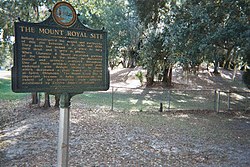Welaka, Florida | |
|---|---|
| Town of Welaka | |
 Brick building along the commercial strip, November 1946 | |
| Motto(s): "Bass Capital of the World" "River of Lakes" | |
 Location in Putnam County and the state of Florida | |
| Coordinates: 29°28′54″N81°40′18″W / 29.48167°N 81.67167°W | |
| Country | |
| State | |
| County | Putnam |
| Settled (Mt. Tucker) | July 6, 1852 [1] |
| Incorporated (Town of Welaka) | June 21, 1887 [1] [2] [3] |
| Government | |
| • Type | Mayor-Council |
| • Mayor | Kimberly Dugger |
| • Council President | Kathy Washington |
| • Council Members | Sandra Walker and Tonya Long |
| • Interim Town Clerk | Stephanie Silva |
| • Town Attorney | Jeremiah Blocker |
| Area | |
• Total | 1.51 sq mi (3.91 km2) |
| • Land | 1.47 sq mi (3.82 km2) |
| • Water | 0.04 sq mi (0.09 km2) |
| Elevation | 26 ft (8 m) |
| Population (2020) | |
• Total | 714 |
| • Density | 484.40/sq mi (187.03/km2) |
| Time zone | UTC-5 (Eastern (EST)) |
| • Summer (DST) | UTC-4 (EDT) |
| ZIP code | 32193 |
| Area code | 386 |
| FIPS code | 12-75750 [5] |
| GNIS feature ID | 0306568 [6] |
| Website | www |
Welaka is a town situated on the St. Johns River in Putnam County, Florida, United States. The town is part of the Palatka, Florida Micropolitan Statistical Area. The population was 714 as of the 2020 census, up from 701 at the 2010 census.


